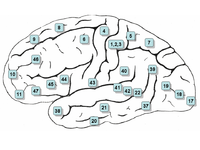
Photo from wikipedia
Children with Attention Deficit Hyperactivity Disorder (ADHD) have prominent deficits in sustained attention that manifest as elevated intra-individual response variability and poor decision-making. Influential neurocognitive models have linked attentional fluctuations… Click to show full abstract
Children with Attention Deficit Hyperactivity Disorder (ADHD) have prominent deficits in sustained attention that manifest as elevated intra-individual response variability and poor decision-making. Influential neurocognitive models have linked attentional fluctuations to aberrant brain dynamics, but these models have not been tested with computationally rigorous procedures. Here we use a Research Domain Criteria approach, drift-diffusion modeling of behavior, and a novel Bayesian Switching Dynamic System unsupervised learning algorithm, with ultrafast temporal resolution (490 ms) whole-brain task-fMRI data, to investigate latent brain state dynamics of salience, frontoparietal, and default mode networks and their relation to response variability, latent decision-making processes, and inattention. Our analyses revealed that occurrence of a task-optimal latent brain state predicted decreased intra-individual response variability and increased evidence accumulation related to decision-making. In contrast, occurrence and dwell time of a non-optimal latent brain state predicted inattention symptoms and furthermore, in a categorical analysis, distinguished children with ADHD from controls. Importantly, functional connectivity between salience and frontoparietal networks predicted rate of evidence accumulation to a decision threshold, whereas functional connectivity between salience and default mode networks predicted inattention. Taken together, our computational modeling reveals dissociable latent brain state features underlying response variability, impaired decision-making, and inattentional symptoms common to ADHD. Our findings provide novel insights into the neurobiology of attention deficits in children.
Journal Title: Molecular Psychiatry
Year Published: 2021
Link to full text (if available)
Share on Social Media: Sign Up to like & get
recommendations!